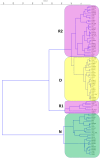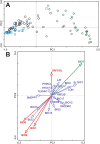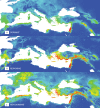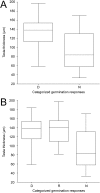Variation in wild pea (Pisum sativum subsp. elatius) seed dormancy and its relationship to the environment and seed coat traits
- PMID: 30656074
- PMCID: PMC6336014
- DOI: 10.7717/peerj.6263
Variation in wild pea (Pisum sativum subsp. elatius) seed dormancy and its relationship to the environment and seed coat traits
Abstract
Background: Seed germination is one of the earliest key events in the plant life cycle. The timing of transition from seed to seedling is an important developmental stage determining the survival of individuals that influences the status of populations and species. Because of wide geographical distribution and occurrence in diverse habitats, wild pea (Pisum sativum subsp. elatius) offers an excellent model to study physical type of seed dormancy in an ecological context. This study addresses the gap in knowledge of association between the seed dormancy, seed properties and environmental factors, experimentally testing oscillating temperature as dormancy release clue.
Methods: Seeds of 97 pea accessions were subjected to two germination treatments (oscillating temperatures of 25/15 °C and 35/15 °C) over 28 days. Germination pattern was described using B-spline coefficients that aggregate both final germination and germination speed. Relationships between germination pattern and environmental conditions at the site of origin (soil and bioclimatic variables extracted from WorldClim 2.0 and SoilGrids databases) were studied using principal component analysis, redundancy analysis and ecological niche modelling. Seeds were analyzed for the seed coat thickness, seed morphology, weight and content of proanthocyanidins (PA).
Results: Seed total germination ranged from 0% to 100%. Cluster analysis of germination patterns of seeds under two temperature treatments differentiated the accessions into three groups: (1) non-dormant (28 accessions, mean germination of 92%), (2) dormant at both treatments (29 acc., 15%) and (3) responsive to increasing temperature range (41 acc., with germination change from 15 to 80%). Seed coat thickness differed between groups with dormant and responsive accessions having thicker testa (median 138 and 140 µm) than non-dormant ones (median 84 mm). The total PA content showed to be higher in the seed coat of dormant (mean 2.18 mg g-1) than those of non-dormant (mean 1.77 mg g-1) and responsive accessions (mean 1.87 mg g-1). Each soil and bioclimatic variable and also germination responsivity (representing synthetic variable characterizing germination pattern of seeds) was spatially clustered. However, only one environmental variable (BIO7, i.e., annual temperature range) was significantly related to germination responsivity. Non-dormant and responsive accessions covered almost whole range of BIO7 while dormant accessions are found in the environment with higher annual temperature, smaller temperature variation, seasonality and milder winter. Ecological niche modelling showed a more localized potential distribution of dormant group. Seed dormancy in the wild pea might be part of a bet-hedging mechanism for areas of the Mediterranean basin with more unpredictable water availability in an otherwise seasonal environment. This study provides the framework for analysis of environmental aspects of physical seed dormancy.
Keywords: Dormancy; Germination; Legumes; Niche-modelling; Pea; Proanthocyanidins; Seed coat; Temperature oscillations; Testa.
Conflict of interest statement
The authors declare there are no competing interests.
Figures







Similar articles
-
A Combined Comparative Transcriptomic, Metabolomic, and Anatomical Analyses of Two Key Domestication Traits: Pod Dehiscence and Seed Dormancy in Pea (Pisum sp.).Front Plant Sci. 2017 Apr 25;8:542. doi: 10.3389/fpls.2017.00542. eCollection 2017. Front Plant Sci. 2017. PMID: 28487704 Free PMC article.
-
The role of the testa during the establishment of physical dormancy in the pea seed.Ann Bot. 2019 May 20;123(5):815-829. doi: 10.1093/aob/mcy213. Ann Bot. 2019. PMID: 30534972 Free PMC article.
-
Anatomy and Histochemistry of Seed Coat Development of Wild (Pisum sativum subsp. elatius (M. Bieb.) Asch. et Graebn. and Domesticated Pea (Pisum sativum subsp. sativum L.).Int J Mol Sci. 2021 Apr 27;22(9):4602. doi: 10.3390/ijms22094602. Int J Mol Sci. 2021. PMID: 33925728 Free PMC article.
-
The role of the testa during development and in establishment of dormancy of the legume seed.Front Plant Sci. 2014 Jul 17;5:351. doi: 10.3389/fpls.2014.00351. eCollection 2014. Front Plant Sci. 2014. PMID: 25101104 Free PMC article. Review.
-
Bet-hedging and variability in plant development: seed germination and beyond.Philos Trans R Soc Lond B Biol Sci. 2024 Apr 22;379(1900):20230048. doi: 10.1098/rstb.2023.0048. Epub 2024 Mar 4. Philos Trans R Soc Lond B Biol Sci. 2024. PMID: 38432313 Free PMC article. Review.
Cited by
-
Characterization of Bioactive Phenolics and Antioxidant Capacity of Edible Bean Extracts of 50 Fabaceae Populations Grown in Thailand.Foods. 2021 Dec 16;10(12):3118. doi: 10.3390/foods10123118. Foods. 2021. PMID: 34945669 Free PMC article.
-
Diversity of Naturalized Hairy Vetch (Vicia villosa Roth) Populations in Central Argentina as a Source of Potential Adaptive Traits for Breeding.Front Plant Sci. 2020 Feb 28;11:189. doi: 10.3389/fpls.2020.00189. eCollection 2020. Front Plant Sci. 2020. PMID: 32180785 Free PMC article.
-
Evaluating relationships between seed morphological traits and seed dormancy in Chenopodium quinoa Willd.Front Plant Sci. 2023 Oct 20;14:1161165. doi: 10.3389/fpls.2023.1161165. eCollection 2023. Front Plant Sci. 2023. PMID: 37929178 Free PMC article.
-
How Could the Use of Crop Wild Relatives in Breeding Increase the Adaptation of Crops to Marginal Environments?Front Plant Sci. 2022 Jun 16;13:886162. doi: 10.3389/fpls.2022.886162. eCollection 2022. Front Plant Sci. 2022. PMID: 35783966 Free PMC article. Review.
-
Fire-released seed dormancy - a global synthesis.Biol Rev Camb Philos Soc. 2022 Aug;97(4):1612-1639. doi: 10.1111/brv.12855. Epub 2022 Apr 6. Biol Rev Camb Philos Soc. 2022. PMID: 35384243 Free PMC article.
References
-
- Ader F. On reducing the proportion of hard seeds in legume seed lots. International Seed Testing Association Proceedings. 1965;30:911–921.
-
- Akaike H. A new look at the statistical model identification. IEEE Transactions on Automatic Control. 1974;19:716–723. doi: 10.1109/TAC.1974.1100705. - DOI
-
- Baskin CC, Baskin JM. Seeds: ecology, biogeography, and evolution of dormancy and germination. Academic Press; San Diego: 2014.
LinkOut - more resources
Full Text Sources
Miscellaneous

